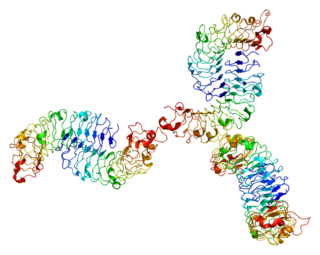
Fibronectin is a high-molecular weight glycoprotein of the extracellular matrix that binds to membrane-spanning receptor proteins called integrins. Fibronectin also binds to other extracellular matrix proteins such as collagen, fibrin, and heparan sulfate proteoglycans.

In biology, the extracellular matrix (ECM) is a three-dimensional network consisting of extracellular macromolecules and minerals, such as collagen, enzymes, glycoproteins and hydroxyapatite that provide structural and biochemical support to surrounding cells. Because multicellularity evolved independently in different multicellular lineages, the composition of ECM varies between multicellular structures; however, cell adhesion, cell-to-cell communication and differentiation are common functions of the ECM.

Proteoglycans are proteins that are heavily glycosylated. The basic proteoglycan unit consists of a "core protein" with one or more covalently attached glycosaminoglycan (GAG) chain(s). The point of attachment is a serine (Ser) residue to which the glycosaminoglycan is joined through a tetrasaccharide bridge. The Ser residue is generally in the sequence -Ser-Gly-X-Gly-, although not every protein with this sequence has an attached glycosaminoglycan. The chains are long, linear carbohydrate polymers that are negatively charged under physiological conditions due to the occurrence of sulfate and uronic acid groups. Proteoglycans occur in connective tissue.

Versican is a large extracellular matrix proteoglycan that is present in a variety of human tissues. It is encoded by the VCAN gene.

Decorin is a protein that in humans is encoded by the DCN gene.

Biglycan is a small leucine-rich repeat proteoglycan (SLRP) which is found in a variety of extracellular matrix tissues, including bone, cartilage and tendon. In humans, biglycan is encoded by the BGN gene which is located on the X chromosome.

Stromelysin-2 also known as matrix metalloproteinase-10 (MMP-10) or transin-2 is an enzyme that in humans is encoded by the MMP10 gene.

Lumican, also known as LUM, is an extracellular matrix protein that, in humans, is encoded by the LUM gene on chromosome 12.

Fibulin-2 is a protein that in humans is encoded by the FBLN2 gene.

Microfibrillar-associated protein 2 is a protein that in humans is encoded by the MFAP2 gene.

WNT1-inducible-signaling pathway protein 1 (WISP-1), also known as CCN4, is a matricellular protein that in humans is encoded by the WISP1 gene.

Prolargin is a protein that in humans is encoded by the PRELP gene.

Beta-1,4-galactosyltransferase 7 also known as galactosyltransferase I is an enzyme that in humans is encoded by the B4GALT7 gene. Galactosyltransferase I catalyzes the synthesis of the glycosaminoglycan-protein linkage in proteoglycans. Proteoglycans in turn are structural components of the extracellular matrix that is found between cells in connective tissues.

Opticin is a protein that in humans is encoded by the OPTC gene.

Asporin is a protein that in humans is encoded by the ASPN gene.

Zinc finger and BTB domain-containing protein 7B is a protein that in humans is encoded by the ZBTB7B gene. ZFP67 is an early growth response gene that encodes a zinc finger-containing transcription factor that binds to the promoter regions of type I collagen genes and has a role in development.[supplied by OMIM]

Dermatopontin also known as tyrosine-rich acidic matrix protein (TRAMP) is a protein that in humans is encoded by the DPT gene. Dermatopontin is a 22-kDa protein of the noncollagenous extracellular matrix (ECM) estimated to comprise 12 mg/kg of wet dermis weight. To date, homologues have been identified in five different mammals and 12 different invertebrates with multiple functions. In vertebrates, the primary function of dermatopontin is a structural component of the ECM, cell adhesion, modulation of TGF-β activity and cellular quiescence). It also has pathological involvement in heart attacks and decreased expression in leiomyoma and fibrosis. In invertebrate, dermatopontin homologue plays a role in hemagglutination, cell-cell aggregation, and expression during parasite infection.

Integrin alpha-11 is a protein that, in humans, is encoded by the ITGA11 gene.

Collagen alpha-1(XXVI) chain is a protein that in humans is encoded by the EMID2 gene.

Tsukushi or tsukushin is an extracellular matrix protein of the small leucine rich proteoglycan (SLRP) family. In humans it is encoded by the TSKU gene.



















